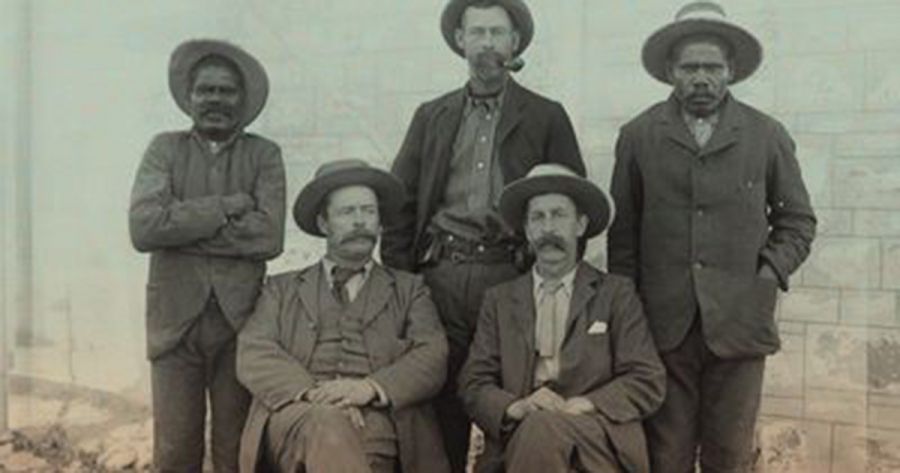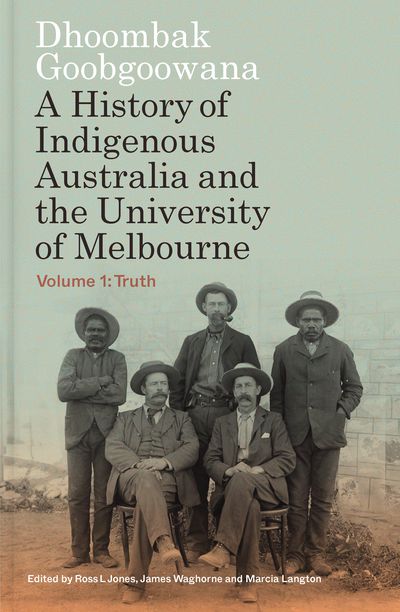
- Free Article: No
- Contents Category: History
- Review Article: Yes
- Article Title: Colonial entanglements
- Article Subtitle: A new kind of university history
- Online Only: Yes
- Custom Highlight Text:
Across more than five hundred pages and written by thirty-three contributors, Dhoombak Goobgoowana contains stories about the University of Melbourne’s relationship with Indigenous Australians.
- Book 1 Title: Dhoombak Goobgoowana
- Book 1 Subtitle: A history of Indigenous Australia and the University of Melbourne, Volume 1: Truth
- Book 1 Biblio: Melbourne University Press, $100 hb, 560 pp
- Book 1 Cover Small (400 x 600):

- Book 1 Cover (800 x 1200):

- Book 1 Readings Link: https://www.readings.com.au/product/9780522881059/dhoombak-goobgoowana--2024--9780522881059#rac:jokjjzr6ly9m
Among the book’s qualities are the diverse strengths and emphases of those who were or are affiliated with Melbourne University in disciplines such as Anatomy, Anthropology, Archaeology, Engineering, History, Law, Linguistics, and Medicine. Museum collections often feature.
The University of Melbourne, founded in 1853 (‘[t]wo years after the colony of Victoria was declared’) has taken the important step of supporting the research and publication of Dhoombak Goobgoowana. It is structured into five interrelated sections: Place, Human Remains, Settler-Colonial Knowledge, Indigenous Knowledge, and a Conclusion. None of these should be read in isolation. Combining empathy with rigour, accessible writing, and substantive referencing, the contributors investigate a range of bruising issues that explore biased knowledge that purposely or inadvertently facilitated the university’s colonial history.
The Human Remains Section is particularly chilling, with its descriptions of the shocking treatment of Aboriginal ancestral remains held in Australian university museums. Marcia Langton, Louise Murray, and Antony Sinni, documenting one appalling example, examine how museums and universities interacted in the last century. They refer to the human remains found in Tasmania that later became known as the ‘Murray Black Collection’, because of the academic who ‘collected’ them. They also describe how Berg, then Head of Victoria’s Koori Trust, took the university to court in 2010, an action that resulted in the repatriation of human remains to their ancestral Tasmanian homelands.
The section titled Settler-Colonial Knowledge highlights the pervasiveness of ignorant and prejudicial views within the academy. Ross L. Jones explores how racist labels were publicly and enduringly imposed on Aboriginal people by university staff.
Authors such as Jones, Langton, and Juliana Kaya Prpic refer to the influence of ‘White superiority’, Social Darwinism, and eugenicist theories. In this respect, Rohan Long discusses a powerful figure, referring to the activities and priorities of Richard Berry, Dean of Medicine from 1906 to 1929.
Kate Auty observes the intellectual prejudice and physical brutality evident in colonial encounters that consistently denied the humanity of Aboriginal Australians. She re-examines the 1926 Forrest River Massacre in Western Australia’s Kimberley and a subsequent inquiry that included witness statements from two university staffers. Auty explains that a former veterinary student, Daniel Murnane, present during the 1926 massacre but against whom no charges were ever laid, later completed a PhD at the university. With the support of then Botany Professor Alfred Ewart, Murnane’s involvement in the massacre, and his subsequent writings about that experience and other aspects of Aboriginal life in the twentieth century, led to both men being criticised for their behaviour – ‘racial prejudice took on a mantle of academic authority’.
In his chapter ‘Stolen Stones and Bare-Faced Brick’, Philip Goad considers the extent to which colonial entanglements influenced the academy’s architecture, engineering, and landscape. He illuminates how the university’s architects and gardeners, environmentally and culturally orchestrated ‘the changing of a landscape that was previously inhabited by the Wurundjeri Woi Wurrung people and traversed by many other Indigenous peoples, such as the Yorta Yorta’, when discussing the Parkville campus. Goad makes it clear that each step forward for the university had quite the opposite effect for Indigenous people.
Jefa Greenaway considers traditional interconnections with lands, particularly how accompanying water sources and lifeways were increasingly eroded by the university, whereas Shawana Andrews takes readers to an unveiling of Billebarry’s Walk, a place hitherto ‘erased’. In hindsight and contemporaneously, of relevance here are the actual, symbolic, practical, and less conspicuous ways that the university, inadvertently or deliberately, expedited the colonial process.
That Australian universities, and the museums many developed, were a resourceful, philanthropic and harmful aid to colonial government authority, social attitudes, and intellectual inquiry, is a key theme of Dhoombak Goobgoowana. Universities and museums played a key role in government policy and practice by providing ‘evidence’ that denied Indigenous intellectual, cultural property, and human rights.
In a distinctive contemporary point of departure, the University of Melbourne has shown how important it is to expose the discriminatory thinking, attitudes, and practices of the past. Tiriki Onus and Sally Treloyn, possibly foreshadowing the NAIDOC 2024 theme of ‘Blak Loud and Proud: Keep the Fire Burning’, outline various changes in the current era. In a superbly crafted chapter, Indigenous people’s long involvement with and increasing public contribution to the arts and cultural aesthetics is outlined by Tiriki Onus and Sally Treloyn. They show how the valuable infusion of Indigenous knowledge and expertise into university curricula in the twenty-first century has resulted in a decolonisation of program communication and design. Aaron Corn, in the same section, explains how the university’s Indigenous Knowledge Institute (IKI), has resulted in enhanced recognition and inclusion of Indigenous knowledges on the Melbourne campus and beyond. Richard Gillespie tells readers about the increasing value of computers and digitisation to Aboriginal reconciliation, including how Indigenous place and other names can and should be revised in all e-communications.
Emphasising Indigenous bush foods and medicine, Jacqueline Healy discusses contemporary and creative ways of improving knowledge, research, and teaching about Indigenous health and healing in the curriculum. Healy’s penultimate chapter also leads to Langton’s incisive Conclusion.
Passionately and rigorously, Langton describes the university’s history with Indigenous people as one that required a ‘reckoning’. Observing the exceptional value of the Yoorook Justice Commission, alongside a truth-telling process underway at the university, Langton indicates that the ‘stain’ left by past interactions needed to be exposed as part of a reconciliation process.
An overriding theme of Dhoombak Goobgoowana is that an assumed authoritative knowledge was accorded to the academy and that it tragically damaged human rights, family interconnections, and the cultural and linguistic life of First Nations people. Identified as Volume 1: Truth, it is likely to be followed by other volumes.
Questions of possible interest from this book’s timely publication include whether it might prompt other Australian universities to review, publicise, and endeavour to reconcile their past with Indigenous Australians. Gunditjmara Elder Jim Berg, whose eloquent memoir opens the book, describes the promise embedded in Dhoombak Goobgoowana this way:
I feel very proud to have been involved in some of the changes that have happened and are happening still at the University, and I am glad that the history of Kooris and the University since the time of colonisation is being told in this book.


Comments powered by CComment